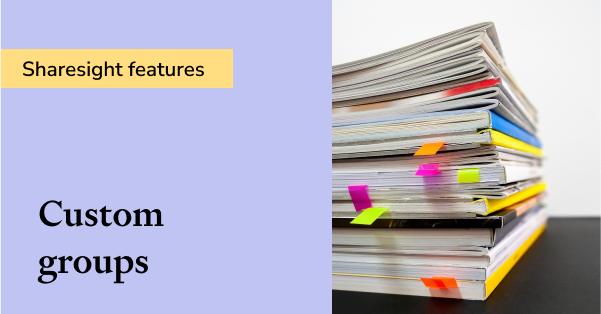Top 10 Sharesight blog posts of 2020
After a year marked by major corrections in markets around the world, and with a new year just around the corner, it’s time to look back and revisit some of the most popular investing-related posts we’ve published on the Sharesight blog in 2020.
Given the turbulent market conditions investors experienced this year, it makes sense that our most-read post was about how to use Sharesight to navigate market volatility. This, along with posts about dividend tracking, calculating capital gains and our top 10 investing movies all made this year’s list.

Here are some of Sharesight’s top blog posts from 2020:
1. 4 ways to navigate market volatility with Sharesight
2020 was the ultimate year for market volatility, from the skyrocketing success of BNPL stocks and US tech giants, to the plummeting share prices of airlines and hotels across the world. Thankfully, Sharesight has a number of clever features to help you keep track of your performance in a volatile market, including detailed performance reports, benchmarking, portfolio sharing and the ability to track capital gains and losses.
2. How I use Sharesight as an investor
Sharesight executive chairman Andrew Bird shares some tips on how DIY investors can get the most out of Sharesight, including how he uses Sharesight to track his own investment portfolio. Some of his suggestions include ensuring all of your holdings are imported (even custom investments such as property), benchmarking your portfolio, setting up Custom Groups and running a Diversity Report.
3. How to track monthly dividend income from your investments
If you’re a dividend income or dividend growth investor, it’s important to be able to track the impact of dividends on your portfolio over time. While there are a number of ways to track dividends in Sharesight, this blog post shows how one Sharesight user tracks his dividend income on a monthly basis using the Future Income Report.
4. How Sharesight calculates your investment performance
Unlike most brokers, Sharesight takes into account the impact of things like dividends, currency fluctuations and the timing of inflows and outflows on your portfolio, giving investors a true picture of their portfolio’s performance. This blog post lists all of the factors Sharesight takes into consideration when calculating investment performance, and how these factors affect your portfolio’s returns.
5. Capital gains tax (CGT) calculator for Australian investors
Taxing capital gains on investments is a common practice throughout the world, but Australia’s capital gains regulations are some of the most complex. This blog post explains the various methods and requirements for calculating capital gains tax on Australian shares.
6. How much money do you need to save for retirement?
One of the main reasons people choose to invest is to build wealth for retirement. However, it can be difficult to determine how much money you will actually need when that time comes. This blog runs through the most important factors to consider in your retirement goals, and offers some tips on calculating how much money you will need.
7. How to get the most out of Sharesight’s performance tracking features
Sharesight has a range of useful features designed to meet the needs of self-directed investors. This post explains some of Sharesight’s most important features, including the Portfolio Overview page; the Performance, Diversity and Contribution Analysis reports; plus how to export any Sharesight report to an Excel, Google Sheets or PDF file format.
8. Explore your portfolio performance with the Contribution Analysis Report
Sharesight’s Contribution Analysis Report displays how each holding inside a user’s portfolio contributes to their overall portfolio performance. Used in tandem with Custom Groups, it becomes a powerful tool that shows the components driving your returns, such as asset allocation or exposure to particular countries, sectors or industries. This blog post shows how a couple uses Sharesight’s Contribution Analysis Report to get a better understanding of their portfolio’s performance.
9. Brokerage fees and your investment performance
When calculating your investment performance, one of the factors Sharesight takes into consideration is the impact of brokerage fees. This post explains why it is important to consider fees when calculating performance, and uses the latest data to show how much of an impact brokerage fees are having on investors’ returns.
10. 10 top investing movies
While working from home during the COVID-19 pandemic, the Sharesight team discussed some of their favourite investment-related movies. This post covers our picks for the 10 best investing movies of all time.
Informed investors track their investments with Sharesight
Thousands of informed investors are already using Sharesight to track their performance and become better investors. What are you waiting for? Sign up and:
-
Track all of your investments in one place, including stocks, ETFs, mutual/managed funds, cash, property and even cryptocurrency
-
See the complete picture of your investment performance, including the impact of brokerage fees, dividends, foreign exchange and capital gains with Sharesight’s annualised performance calculation methodology
-
Run powerful reports built for investors, such as Performance, Portfolio Diversity, Contribution Analysis and Future Income (upcoming dividends)
-
Easily share access of your portfolio with family members, your accountant or other financial professionals so they can see the same picture of your investments as you do
Sign up for a FREE Sharesight account and start tracking your investment performance (and tax) today.
FURTHER READING

8 ways to use Sharesight's custom groups feature
This blog explains our custom groups feature, including strategies that can help you gain deeper portfolio insights and make more informed investing decisions.

You can time the market – and ETFs are the way to do it
Marcus Today founder and director Marcus Padley discusses timing the market, and how investors can do this using exchange-traded funds (ETFs).

Morningstar analyses Australian investors’ top trades: Q1 2025
Morningstar reviews the top 20 trades by Australian Sharesight users in Q1 2025, and reveals where their analysts see potential opportunities.